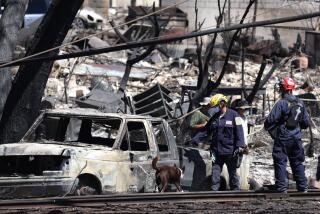Archaeologists have a new way to unlock the secrets of ancient burned bones
- Share via
Ancient bones, burned beyond repair, have been given new life to tell their stories, thanks to beams of neutrons.
Using new techniques to analyze molecules in bones, scientists have narrowed down the temperatures used to burn skeletal remains that are as much as 8,000 years old — shedding light on long-ago funeral and cooking practices as well as advancing modern forensic science.
When bones are burned, it completely changes their overall size and shape. Structural features “that are useful for archaeologists to know the story of the remains are lost,” said Giulia Festa, a physicist at the Enrico Fermi Historical Museum of Physics and Study and Research Center in Rome.
But even when fire alters bone beyond visible recognition, their molecules can still provide clues to their history, according to a study led by Festa that was published Friday, in Science Advances.
“Every molecule is constantly vibrating, although of course, we cannot see it,” said Maria Paula Marques, a chemist at the University of Coimbra in Portugal and the study’s senior author. “If we apply the proper instrument, which in this case is called a vibrational spectrometer, we can plot a graph of these vibrations.”
The vibrarions of each molecule are unique, like a fingerprint.
As the temperature of a bone increases, the composition and arrangement of its molecules changes. As the bone structure deforms, the molecules are pushed and pulled in new ways. And as heat causes water to evaporate and carbon dioxide to be released, the bones’ chemical makeup changes as well.
And when the molecules change, so do their vibrations. Measuring these vibrations allows scientists to understand how bones change when exposed to very high temperatures.
Enter spectroscopy, a way to examine matter by seeing how it interacts with a beam of light.
With Raman spectroscopy, the frequency of the light changes in characteristic ways for particular types of molecules. And with infrared spectroscopy, molecules absorb specific frequencies of light, giving away their identity.
Both methods provide complementary information, but sometimes one gives clearer results than the other. For example, vibrations that may appear weak based on Raman spectroscopy could look stronger when measured with infrared spectroscopy, Marques said, and the combination is another way to zero in on the identity of a particular molecule.
The third method the researchers used, called inelastic neutron scattering spectroscopy, is much less common. Instead of light, it uses a beam of neutrons to identify vibrations.
Creating a beam of neutrons is no easy feat.
“There’s plenty of neutrons around,” said Stewart Parker, an instrument scientist with the Rutherford Appleton Laboratory in England who worked on the study. Unfortunately, he said, “they’re actually very strongly held inside the atom.”
To release the neutrons, scientists use a process called spallation.
“If you take a hammer and smack a rock with it, you get little bits of stuff flying around. These are spallation fragments,” Parker said. “We do exactly the same thing here, except that in this case, our hammer is a high-energy beam of protons. The proton hits the tungsten atom, and as a result of that, we generate neutrons.”
These neutrons then bombard the molecules in bone, revealing vibrations that could not be detected by Raman or infrared spectroscopy.
“There are vibrations that involve the hydrogen [atoms] that could not be seen if we could not use neutron spectroscopy,” Marques said. “So having these three techniques for the same sample gives us the complete set of vibrations and much more information.”
In earlier work, Marques, Parker and a team of scientists took modern human bones and burned them at temperatures ranging from 400°C to 1000° Celsius. Along the way, they used the three spectroscopy techniques to see how the vibrations of the molecules changed in response to different levels of heat.
Then they were ready to test their system on ancient bones, using the modern bones as a reference.
“We wanted to see if we could obtain reliable information for different historical periods,” Marques said. “From those different historical periods, civilizations would handle their deaths in different ways.”
The researchers analyzed bones from four archaeological sites in Italy that represented four historical eras: the Neolithic, the Copper Age, the Roman Empire and the Middle Ages.
The molecules in a human tibia from the medieval site (which was inhabited between the years 500 to 1400 CE) revealed that the bone had likely been burned at a temperature close to 400°C, while a skull was likely burned at 600°C, the researchers said.
Human hand bones from a Copper Age site (in use between 3360 and 2910 BCE) were found to have been burned at 500° C, the temperature of a common home fire. Cremations were known to be a regular burial practice at the time, and this finding suggests people could have conducted them in their homes, the researchers said.
The researchers were surprised to find that four bones from the same skeleton in a Roman tomb were burned at vastly different temperatures — some less than 400°C and some as high as 900°C. The skeleton (dated to between 100 and 200 CE) was found entombed with a lamp.
“In those times, many times people inserted a lamp in the tombs with their dead,” Marques said. Because the lamp was closer to one type of bone than the other, she said, “we realized that the skeleton was in the fetal position.”
The researchers also tested a burned jaw bone from a Neolithic sheep or goat that found its way into a central Italy cave between 6000 and 5000 BCE. Using human bones as a comparison, the researchers found that the bone appeared to have been burned at a temperature below 500°C, consistent with the cooking temperatures of Neolithic ovens.
Not only do these methods uncover secrets about how humans lived in the past, they may have important uses in modern-day forensic investigations.
“When you look at normal bones, there’s a pretty good correlation between the size of the bone and the size of the individual,” Parker said. But “when you burn it, bone shrinks, so the correlation doesn’t work.”
Tim Thompson, a forensic anthropologist at England’s Teesside University who wasn’t involved in the study, agreed that the new method of examining bones would be useful for studying specimens throughout history.
“Bone is bone, and it doesn’t really matter whether it’s a modern forensic context or a historic context,” he said. “You’re still looking fundamentally at the same material that’s undergoing the same change.”






